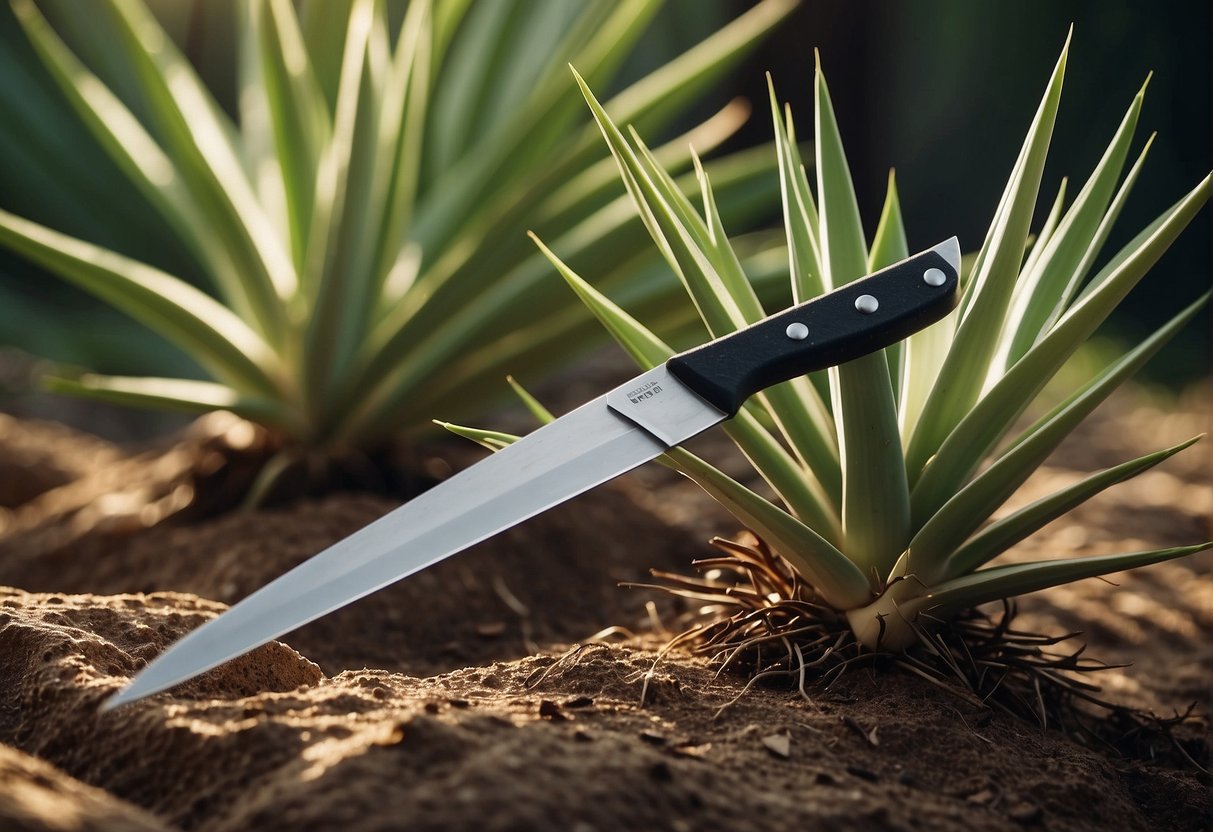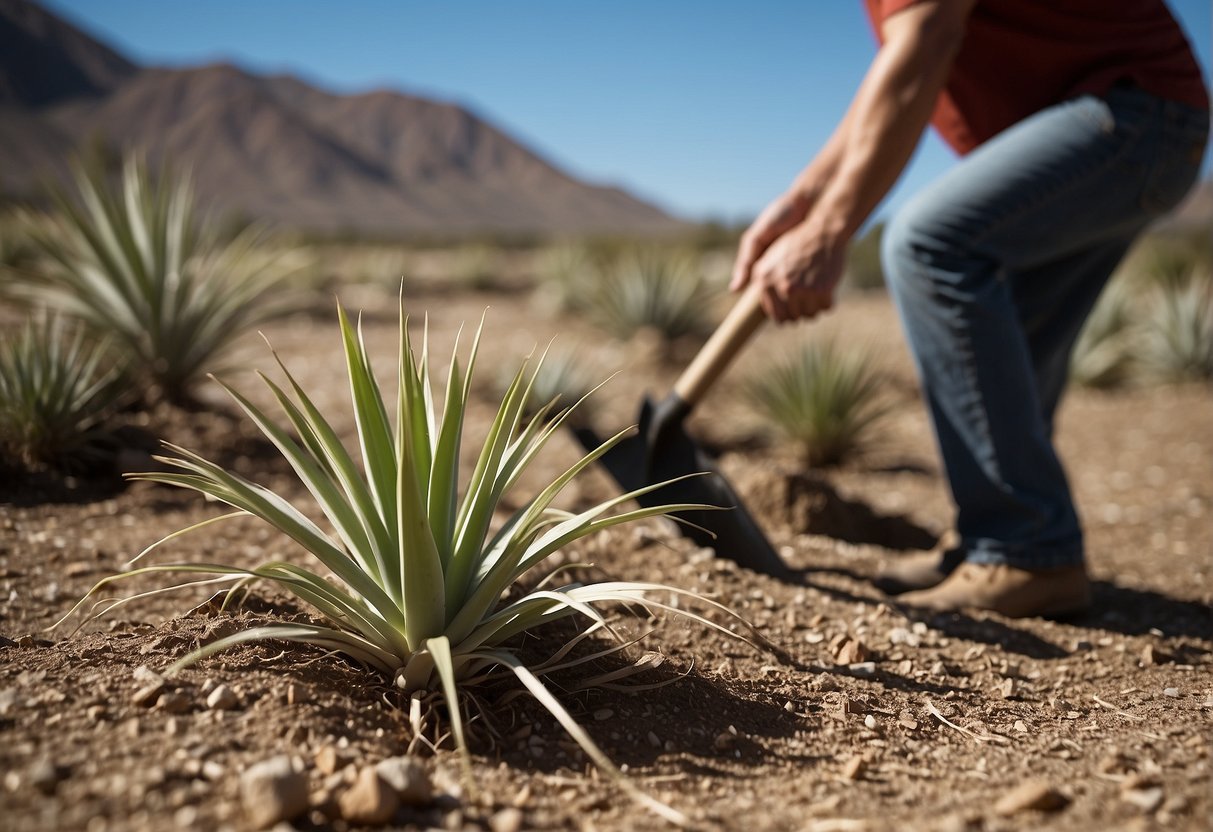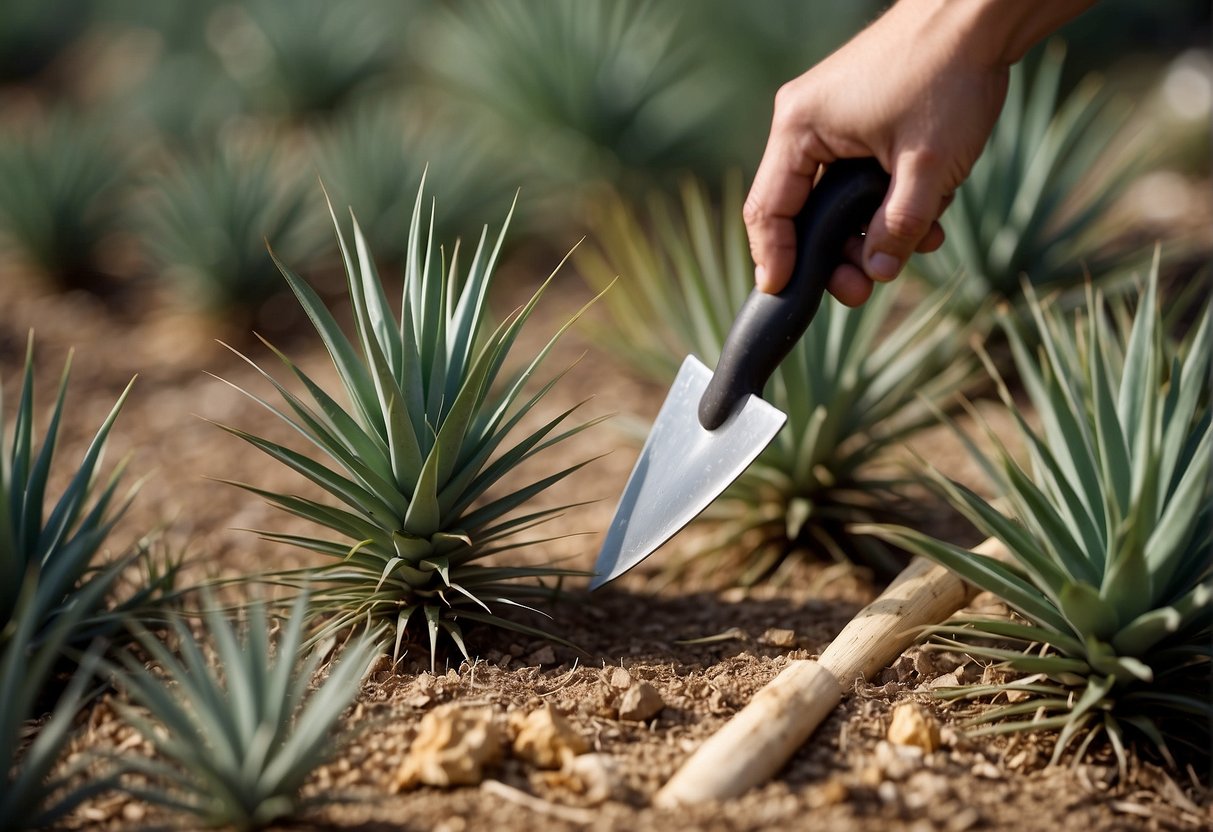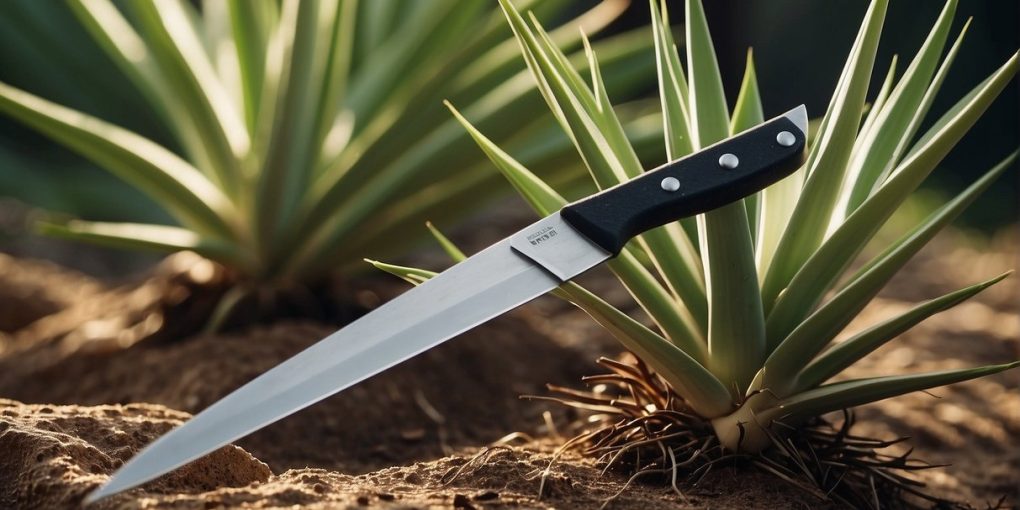How to Split Yucca Plants: A Step-by-Step Division Guide
Dividing yucca plants is an effective method to control their size and to start new plants for use in landscaping. These durable, easy-to-care-for plants can outgrow their allocated spaces or might need a bit of revitalization. When you split yucca plants, you’re not only promoting the health and robustness of these water-wise perennials, but you’re also beautifying your garden with their impressive foliage.

Before attempting to split a yucca, it’s essential to understand the specific needs and structure of these plants. Proper preparation is key to successful division, which involves protective gear, sharp tools, and an understanding of the plant’s root system. With the right approach, you can safely divide yucca plants, encouraging a strong start for the new plantings.
After dividing, planting the yucca sections promptly is crucial to their survival. Place them at the appropriate depth in well-draining soil, and provide consistent but not excessive water as they establish. Ongoing care, including the correct balance of sunlight and moisture, will see your yucca thrive, while being informed on how to troubleshoot common problems keeps them healthy for years to come.
Key Takeaways
- Splitting yuccas helps manage their size and promote garden health.
- Proper preparation and understanding of yuccas ensure successful division.
- Appropriate planting and care foster divided yuccas’ growth and longevity.
Understanding Yucca Plants
Splitting yucca plants starts with knowing the plant itself. This section covers the critical attributes of yuccas and the conditions they thrive in.
Characteristics of Yucca
Yuccas are hardy, long-lived plants known for their rosettes of tough, sword-like leaves and stunning white flowers. They come in various forms from shrub-like plants to trees, with some common varieties being Yucca gigantea, often referred to as spineless yucca or yucca cane, and the treelike Yucca brevifolia, native to North America.
- Foliage: Ranging from dark green to bluish-gray, the leaves may bear sharp edges or be soft and spineless.
- Flowers: The blooms are typically white or cream and bell-shaped, highly attractive during the flowering season.
- Growth Habit: Mature yucca plants often develop a ‘crown’ of foliage atop sturdy trunks or stems.
Ideal Growing Conditions
To ensure your yucca plant prospers, provide it with:
- Soil: Well-draining soil is essential, with sandy conditions being particularly favorable. Yuccas cannot tolerate waterlogged roots.
- Water: Yucca plants are drought-tolerant, requiring minimal watering. Overwatering can lead to root rot.
- Light: These plants demand full sun, relishing in direct sunlight for the majority of the day.
- Temperature: Yuccas do well in a range of temperatures, but they prefer mild winters and hot summers. They are most commonly found in areas with blazing hot summers.
By understanding and replicating these conditions, you set the stage for successful yucca plant care and propagation.
Preparation for Dividing Yucca

Successful division of yucca plants begins with thorough preparation. Having the correct tools and understanding the optimum time for division will ensure the health of the main plant and its offshoots.
When to Divide Yucca
Early spring is the best time for dividing yucca plants, as they are still dormant. This allows the plant to recover and establish itself before the growing season. Look for signs that your yucca is becoming crowded or if the growth seems inhibited, indicating that it might benefit from division.
Tools and Safety Gear
The required tools for dividing yucca should include:
- Shovel: For digging around the root system.
- Sharp knife or saw: To cut through tough roots and rhizomes.
- Gloves: To protect your hands.
Wearing sturdy pants and a long-sleeved shirt is advisable to prevent skin irritation from the yucca’s foliage.
Assessing the Yucca for Division
Before proceeding, closely inspect the yucca’s root system for rot or rotted roots, which could indicate that the plant is not healthy enough for division. Identify the sections of the plant with a visible cluster of roots and rhizomes. These are the parts of the yucca that will develop into a new plant. Be sure to identify any offshoots, as these can often be the easiest to divide and replant.
Dividing Yucca Plants

When dividing yucca plants, the goal is to propagate new, healthy plants from the parent while ensuring minimal damage to both the original and the offshoots. Accurate cuts and proper handling are crucial for success.
Steps for Separating Yucca
- Preparing: Choose a day with mild weather for the division. Water your yucca plant thoroughly a day before to ensure the roots are hydrated and more pliable.
- Digging Up: Use a sharp shovel to dig around the parent plant carefully. Aim to remove a large amount of soil to avoid cutting into the root system.
- Lifting Out: Gently lift the entire plant out of the ground, minimizing rough handling to protect its structural integrity.
- Cleaning Roots: Shake off excess soil and rinse roots if necessary to clearly see the points of division.
- Dividing: With a sharp knife or shovel, make clean cuts to separate small rhizomes or larger sections as desired. Ensure each division has at least one growth point or stem.
Handling Offshoots and Pups
- Identifying Offshoots: Look for pups, or baby yucca plants, clustered around the base of the parent. These should have their own roots forming.
- Separation: Gently pull the pups away from the main root mass. If they are attached firmly, use a sharp knife to sever them with a clean cut.
- Potting Up: Plant pups in fresh soil immediately, watering lightly to establish them in their new environment.
Stem and Rhizome Division
- Stem Cuttings: For yucca varieties with stems, you can propagate by cutting a section of the stem complete with leaves. Plant stem cuttings in fresh soil, ensuring they are upright for proper growth.
- Rhizome Division: Use your sharp shovel to slice through thick rhizome sections connected to the main root ball. Each piece should have at least one growth point to develop into a new plant.
Planting Divided Yucca
After splitting your yucca plant, the next step involves the careful planting of each division to ensure successful growth. Your choice of location, as well as how you handle potting, are crucial to encourage new growth.
Choosing the Right Location and Soil
When selecting a location for your yucca, seek out an area that receives plenty of light and has well-drained soil. If planting outdoors, test the ground by digging a small hole eight inches deep and filling it with water; if the water drains within 30 minutes, the soil is likely suitable. For better drainage, consider amending the soil with compost and grit to prevent waterlogging, which can be detrimental to the roots.
Potting and Repotting Yuccas
For potting, select a new pot with ample drainage holes to prevent excess water from accumulating. A mix of potting soil, grit, and compost ensures good drainage and provides essential nutrients. When repotting, be gentle with the roots and ensure the yucca sits at the same depth as it did in the previous pot. Firm the soil lightly around the plant to secure it in place and encourage better rooting.
Establishing New Yucca Plants
Water your newly potted yucca sparingly; overwatering can impede root development. Allow the top layer of soil to dry out between watering sessions. Yuccas are drought-tolerant and excessive moisture can lead to rot. Observe your yucca’s growth and adjust care if necessary, but remember, patience is key. It may take some time for the plant to become established and show new growth.
Ongoing Care and Maintenance
Proper care ensures your yucca thrives, focusing on specific watering, light, and pruning practices.
Watering and Fertilizing
Yuccas are drought-tolerant succulents that require minimal watering. Adhere to the following watering schedule:
- Spring and Summer (active growing seasons): Water once a week when the top inch of soil is dry.
- Fall and Winter (dormant periods): Reduce watering to every other week.
Fertilization should be minimal. Feed yucca plants with a balanced, water-soluble fertilizer at half-strength every month during spring and summer only.
Do not fertilize in fall and winter.
Managing Light and Temperature
Yuccas need full sun to partial shade to maintain their hardy foliage. Ensure the following:
- Indoor Yuccas: Position near a south-facing window.
- Outdoor Yuccas: Plant in an area receiving 6+ hours of direct sunlight daily.
Yuccas can tolerate a range of temperatures, but they thrive in:
- 65°F to 90°F (18°C to 32°C) during spring and summer.
- Not below 50°F (10°C) in the colder months.
Pruning and Clean-Up
Pruning maintains your yucca’s appearance and health. Follow these steps:
- Remove Dead or Dying Leaves: Gently pull away from the base or cut with clean shears.
- Prune for Size: Trim the top growth to manage height.
Prune in the spring or early summer when the plant is actively growing. Always remove lower leaves that are brown or drooping to encourage new growth and maintain a tidy appearance.
Troubleshooting Common Problems
When splitting yucca plants, you may encounter several issues that can hinder the health of your plant. Being equipped with the right solutions will empower you to handle these obstacles effectively.
Dealing with Pests and Diseases
- Inspect Regularly: Check your yucca plants for signs of pests like aphids and scales, as well as diseases such as rot. Early detection is crucial.
- Apply Treatments: If pests are present, use a mild insecticidal soap or neem oil. For root rot, remove the affected parts and let the soil dry.
| Problem | Solution |
|---|---|
| Aphids | Apply insecticidal soap or neem oil |
| Scales | Use horticultural oil or alcohol swabs |
| Root rot | Remove rotted parts; let soil dry |
Addressing Overwatering Symptoms
- Adjust Watering: Cut back on watering immediately if you notice soggy soil or yellowing leaves.
- Improve Drainage: Ensure your pot has drainage holes and consider adding perlite or sand to the potting mix to prevent waterlogged conditions.
Signs of Overwatering:
- Yellow leaves
- Soggy soil
- Soft, brown roots (rotted roots)
Mitigating Environmental Stress
- Acclimatize Your Yucca: Gradually introduce your plant to new environments; sudden changes can cause stress.
- Protect from Extremes: Keep your plant in a location where it can avoid excessive heat, cold, and direct harsh sunlight.
Remember, proper care and immediate action can make all the difference in ensuring the successful splitting and propagation of your yucca plants.
Frequently Asked Questions
When dividing yucca plants, it is important to use a sharp, clean tool to avoid damaging the plant, and ensure each division has roots attached for successful replanting.
How do you properly divide a large yucca plant for replanting?
To divide a large yucca plant, carefully dig around the plant and lift it from the ground. Look for natural divisions and gently separate them with a sharp spade or knife. Ensure that each division has a portion of the root system.
What steps are involved in propagating yucca from side shoots?
To propagate yucca from side shoots, locate a healthy shoot and cut it off at the base with a clean, sharp tool, making sure some roots are attached. Allow the shoot to dry for a day before planting in well-draining soil.
Is it possible to cut and replant a yucca plant successfully?
Yes, you can cut and replant a yucca plant successfully by selecting a healthy stem, cutting it with a sterile blade, and allowing the cut end to callous before planting it in a pot with well-draining soil.
What is the best method to split yucca plants growing in pots?
For yucca plants growing in pots, remove the plant from the pot and brush off excess soil to reveal the root ball. Look for natural sections and carefully tease them apart before repotting each into appropriate-sized containers with fresh potting mix.
How can you propagate Adam’s needle Yucca through division?
Propagate Adam’s needle Yucca by unpotting the plant, dividing it with a clean cut between the sections of roots and stems, and then potting each division into its own container with fresh soil mix.
Can yucca cuttings be planted directly into soil, and if so, how?
Yucca cuttings can be planted directly into soil. After taking a cutting with a clean tool, let the end callous over for a few days. Then, dip the end in rooting hormone and plant in a pot with a well-draining soil mixture, keeping it lightly moist until established.



